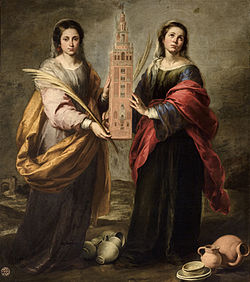Justa and Rufina | |
|---|---|
 | |
| Born | Justa, 268 AD; Rufina 270 AD |
| Died | 287 AD |
| Venerated in | Catholic Church, Eastern Orthodox Church [1] |
| Major shrine | Seville |
| Feast | 19 July (17 July in the medieval Hispanic liturgy) |
| Attributes | A model of the Giralda; earthenware pots, bowls and platters; books on which are two lumps of potter's clay; palms of martyrdom; lion [2] |
| Patronage | Seville; potters; guilds of alfareros (potters) and cacharreros (sellers of pottery) |
Saints Justa and Rufina (Ruffina) (Spanish : Santa Justa y Santa Rufina) are venerated as martyrs. They are said to have been martyred at Hispalis (Seville) during the 3rd century.
Contents
Only St. Justa (sometimes "Justus" in early manuscripts) is mentioned in the Martyrologium Hieronymianum (93), but in the historical martyrologies. Rufina is also mentioned, following the legendary Acts. [3] The two saints are highly honored in the Mozarabic Liturgy. [4]








